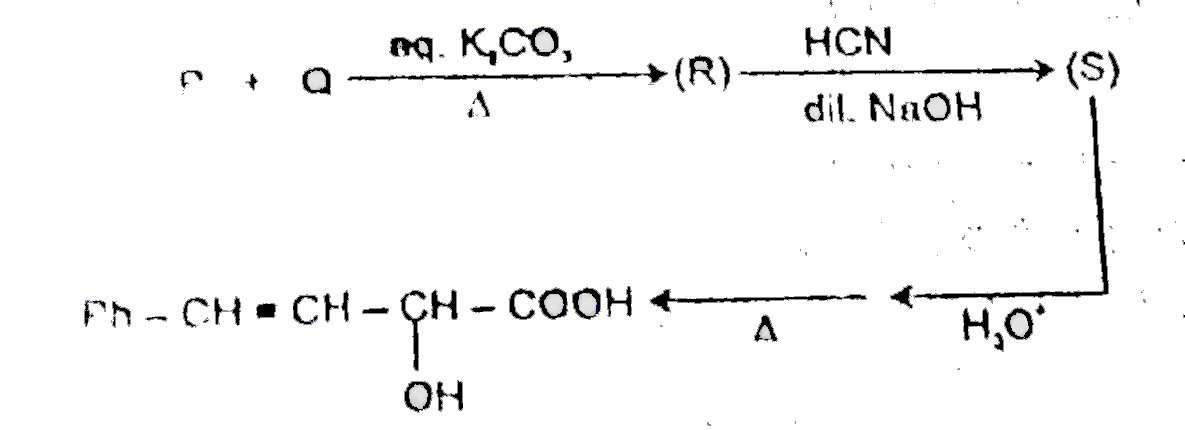A compound (P) on reaction with "Q" in basic medium (KOH) gives a bad smelling compound (CH3CH2NC). Compound Q can be prepare by reaction with calcium hypochlorite [Ca(OCl)2] P and Q can :
CH3−CH2−NH2&CHCl3
CH3−CH2−NO2&CH3Cl
CH3−CH2−NH−CH3&COCl2
(CH3−CH2)3N&Cl2
The correct Answer is:A
To solve the problem, we need to identify the compounds P and Q based on the information provided. Let's break down the steps:
Step 1: Identify Compound Q
1. Understanding the Reaction: Compound Q is prepared by reacting calcium hypochlorite (Ca(OCl)₂) with water. This reaction produces chlorine gas (Cl₂) and calcium hydroxide (Ca(OH)₂).
2. Hydrolysis of Calcium Hypochlorite:
Ca(OCl)2+H2O→Cl2+Ca(OH)2
3. Chlorination of Ethanol: The chlorine gas can react with ethanol (C₂H₅OH) in the presence of calcium hydroxide to form chloroform (CHCl₃).
4. Final Compound Q: After the chlorination process, we find that compound Q is chloroform (CHCl₃).
Step 2: Identify Compound P
1. Understanding the Reaction with Q: We know that compound P reacts with chloroform (Q) in a basic medium (KOH) to produce a bad-smelling compound, which is ethyl isocyanide (CH₃CH₂NC).
2. Reaction of Ethyl Amine with Chloroform: The compound P that reacts with chloroform is ethyl amine (C₂H₅NH₂).
3. Reaction Equation:
C2H5NH2+CHCl3+KOH→C2H5NC+KCl+H2O
Here, ethyl amine reacts with chloroform in the presence of KOH to yield ethyl isocyanide.
Conclusion
- Compound P: Ethyl amine (C₂H₅NH₂)
- Compound Q: Chloroform (CHCl₃)
Final Answer
- P is ethyl amine (C₂H₅NH₂)
- Q is chloroform (CHCl₃)
1. Understanding the Reaction: Compound Q is prepared by reacting calcium hypochlorite (Ca(OCl)₂) with water. This reaction produces chlorine gas (Cl₂) and calcium hydroxide (Ca(OH)₂).
2. Hydrolysis of Calcium Hypochlorite:
Ca(OCl)2+H2O→Cl2+Ca(OH)2
3. Chlorination of Ethanol: The chlorine gas can react with ethanol (C₂H₅OH) in the presence of calcium hydroxide to form chloroform (CHCl₃).
4. Final Compound Q: After the chlorination process, we find that compound Q is chloroform (CHCl₃).
1. Understanding the Reaction with Q: We know that compound P reacts with chloroform (Q) in a basic medium (KOH) to produce a bad-smelling compound, which is ethyl isocyanide (CH₃CH₂NC).
2. Reaction of Ethyl Amine with Chloroform: The compound P that reacts with chloroform is ethyl amine (C₂H₅NH₂).
3. Reaction Equation:
C2H5NH2+CHCl3+KOH→C2H5NC+KCl+H2O
Here, ethyl amine reacts with chloroform in the presence of KOH to yield ethyl isocyanide.
- Compound P: Ethyl amine (C₂H₅NH₂)
- Compound Q: Chloroform (CHCl₃)
- P is ethyl amine (C₂H₅NH₂)
- Q is chloroform (CHCl₃)
Topper's Solved these Questions
- BOOK - RESONANCE ENGLISHCHAPTER - STRUCTURAL IDENTIFICATION & PRACTICAL ORGANIC CHEMISTRYEXERCISE - Part-III27videos
STRUCTURAL IDENTIFICATION & PRACTICAL ORGANIC CHEMISTRY
- BOOK - RESONANCE ENGLISHCHAPTER - STRUCTURAL IDENTIFICATION & PRACTICAL ORGANIC CHEMISTRYEXERCISE - Additional theory4videos
STRUCTURAL IDENTIFICATION & PRACTICAL ORGANIC CHEMISTRY
- BOOK - RESONANCE ENGLISHCHAPTER - STRUCTURAL IDENTIFICATION & PRACTICAL ORGANIC CHEMISTRYEXERCISE - Jee main6videos
STRUCTURAL IDENTIFICATION & PRACTICAL ORGANIC CHEMISTRY
- BOOK - RESONANCE ENGLISHCHAPTER - SOLID STATEEXERCISE - Part- IV21videos
SOLID STATE
- BOOK - RESONANCE ENGLISHCHAPTER - THERMODYNAMIC & THERMOCHEMISTRYEXERCISE - INORGANIC CHEMISTRY(P-Block Elements)26videos
THERMODYNAMIC & THERMOCHEMISTRY
Similar Questions
CH4 can be prepared by the reaction of H2O with:
View SolutionA compound (A) is formed by the reaction of ethylene with bromine which on reacting with aqueous KOH gives a compound (B). The compound (B) can also be prepared by the reaction of ethylene with the following:
View SolutionAn organic compound A’ with molecular formula C7H7NO reacts with Br2/aqKOH to give compound B’, which upon reaction with NaNO2&HCl at O∘C gives C’. Compound C’ on heating with CH3CH2OH gives a hydrocarbon D’. Compound B’ on further reaction with Br2 water gives white precipitate of compound E’. Identify the compound A, B, C, D&E, also justify your answer by giving relevant chemical equations.
View SolutionGive the IUPAC name of the compound
CH3−CH(Cl)−CH2−CH3View SolutionGive the IUPAC name of the compound
CH3−O−CH2−CH2−CH3View SolutionGive the IUPAC name of the compound
CH3−CH2−O−CH2−CH3View SolutionConsider the following reaction , the compounds P and Q are respectively
 View Solution
View SolutionTwo isomeric compounds
Cl−CH2−CH2−CH2ClandCH3−CH2−CHCl2 can be distinguished by the use ofView SolutionGive the IUPAC name of the following compound is :
Cl−CH2−CH2−CH2−CH2−CH2−CHO.View SolutionConsider the following reaction sequence

The compounds P and Q are :View Solution

